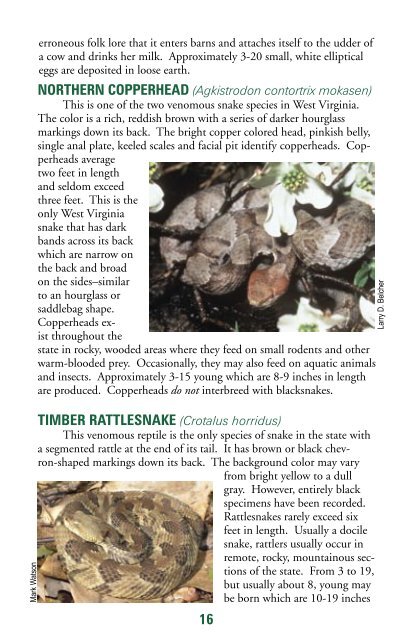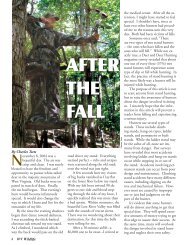Snakes - West Virginia Division of Natural Resources
Snakes - West Virginia Division of Natural Resources
Snakes - West Virginia Division of Natural Resources
Create successful ePaper yourself
Turn your PDF publications into a flip-book with our unique Google optimized e-Paper software.
Mark Watson<br />
erroneous folk lore that it enters barns and attaches itself to the udder <strong>of</strong><br />
a cow and drinks her milk. Approximately 3-20 small, white elliptical<br />
eggs are deposited in loose earth.<br />
NORTHERN COPPERHEAD (Agkistrodon contortrix mokasen)<br />
This is one <strong>of</strong> the two venomous snake species in <strong>West</strong> <strong>Virginia</strong>.<br />
The color is a rich, reddish brown with a series <strong>of</strong> darker hourglass<br />
markings down its back. The bright copper colored head, pinkish belly,<br />
single anal plate, keeled scales and facial pit identify copperheads. Copperheads<br />
average<br />
two feet in length<br />
and seldom exceed<br />
three feet. This is the<br />
only <strong>West</strong> <strong>Virginia</strong><br />
snake that has dark<br />
bands across its back<br />
which are narrow on<br />
the back and broad<br />
on the sides–similar<br />
to an hourglass or<br />
saddlebag shape.<br />
Copperheads exist<br />
throughout the<br />
state in rocky, wooded areas where they feed on small rodents and other<br />
warm-blooded prey. Occasionally, they may also feed on aquatic animals<br />
and insects. Approximately 3-15 young which are 8-9 inches in length<br />
are produced. Copperheads do not interbreed with blacksnakes.<br />
TIMBER RATTLESNAKE (Crotalus horridus)<br />
This venomous reptile is the only species <strong>of</strong> snake in the state with<br />
a segmented rattle at the end <strong>of</strong> its tail. It has brown or black chevron-shaped<br />
markings down its back. The background color may vary<br />
from bright yellow to a dull<br />
gray. However, entirely black<br />
specimens have been recorded.<br />
Rattlesnakes rarely exceed six<br />
feet in length. Usually a docile<br />
snake, rattlers usually occur in<br />
remote, rocky, mountainous sections<br />
<strong>of</strong> the state. From 3 to 19,<br />
but usually about 8, young may<br />
be born which are 10-19 inches<br />
16<br />
Larry D. Belcher












